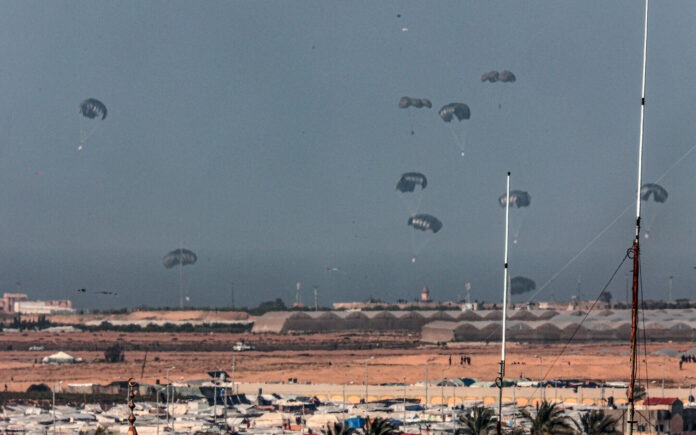The humanitarian crisis in Gaza has reached a breaking point. Over 576,000 Palestinians – one quarter of Gaza’s population – are on the verge of famine, according to the UN. With people eating animal feed and cacti to survive, the US military has now launched a life-saving mission to airdrop food, water and medical supplies into the region.
On Friday, President Joe Biden announced the US would carry out airstrikes to deliver aid across Gaza. This comes after heartbreaking scenes earlier this week, where over 100 Palestinians were killed in a stampede while desperately trying to reach a UN aid convoy.
“We need to do more and the United States will do more,” said Biden, confirming the first aid packages would be dropped this weekend. This isn’t going to be one and done,” added White House spokesperson John Kirby, implying this would be an ongoing relief effort by the US military.
A Complex Humanitarian Mission
Delivering supplies by air into Gaza poses huge logistical challenges. With over 2 million Palestinians densely packed into the narrow 25 mile-long strip, accurately dropping pallets of aid across destroyed neighborhoods will require expert precision.
C-17 and C-130 cargo planes are expected to be used by the US Air Force to carry out these aid drops. It is something that’s right up their mission alley,” explained retired USAF General David Deptula, who previously oversaw no-fly zone operations in Iraq. “There are a lot of detailed challenges. But there’s nothing insurmountable.”
To maximize efficiency and avoid accidents, the US military will likely carry out these airdrops at night or in the early morning, when the lowest number of Palestinians are outdoors. They will also need to carefully coordinate with the UN and other aid agencies working on the ground in Gaza.
Aid Groups Welcome US Intervention, But Caution Long-Term Solution Needed
Aid organizations working tirelessly in Gaza have largely welcomed Biden’s announcement. “Any additional supplies will at least alleviate some suffering in Gaza,” noted Richard Gowan, UN Director at the International Crisis Group.
However, Gowan pointed out airdrops are usually “good photo opportunities but a lousy way to deliver aid” compared to ground convoys through Gaza’s land crossings. He argued the only long-term solution is a ceasefire deal to enable safe passage of aid convoys into Gaza.
Opening up maritime supply lines could be another option. The White House says its exploring ways to ship aid from Cyprus – just 200 miles off Gaza’s coastline – and other nearby maritime hubs. But establishing a sea corridor would likely require tacit approval from Israel.
Tricky Coordination With Israel Over Access to Gaza
While the US has publicly called on Israel to allow more aid into Gaza, it’s unclear whether Israel has signed off on America’s airdrop plans. An Israeli official confirmed they were “aware” of the mission, but didn’t confirm any coordination with US forces.
This lack of cooperation reflects ongoing tensions between the Biden administration and Israel’s new far-right government. Biden has condemned Israel’s blockade on Gaza as “counterproductive” for peace efforts. However, he’s hesitated from demanding Israel fully open access to Gaza thus far.
America supplying aid directly by air could let Biden sidestep dealing directly with Israel over Gaza’s sealed land crossings for now. But unless the fundamental access issues are resolved, these US airdrops will only provide temporary relief.
First Airdrops Seen as Symbolic Gesture, But US Vows Ongoing Support
The initial aid bundles from US planes will include ready-to-eat meals, drinking water and critical medical supplies. While only a limited amount can be airlifted on the first runs, the White House confirmed this will kickstart a “sustained effort.”
These initial airdrops have been criticized as a symbolic gesture, unable to meet Gaza’s vast humanitarian needs. However, the US military’s vast airlift capabilities mean these air drops could ramp up significantly over time.
During the Berlin airlift of 1948-49, US and British planes supplied up to 13,000 tons of food per day into blockaded West Berlin. This helped sustain over 2 million West Berliners for 11 months. Given Gaza’s smaller population size, experts believe the US has the capability to airlift substantial aid over an extended period if needed.
Of course, Gaza’s fundamental problem can’t be solved from the air alone. But combined with ceasefire negotiations, practical discussions to open land and sea access, and close coordination with aid groups, the US military’s airdrop mission could help save many Palestinian lives in the weeks ahead.





















